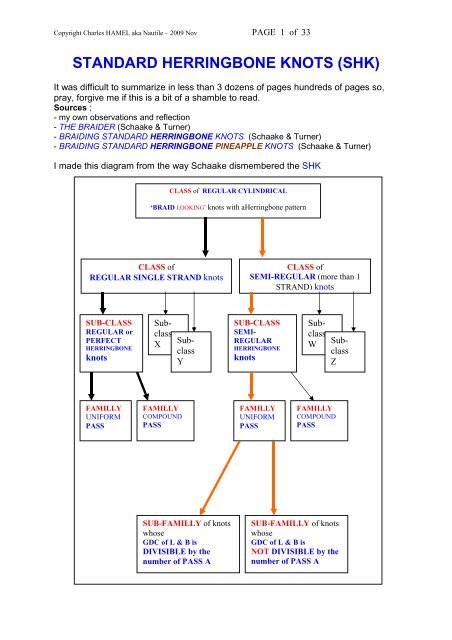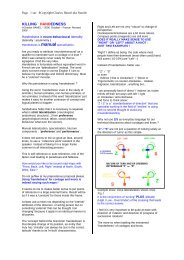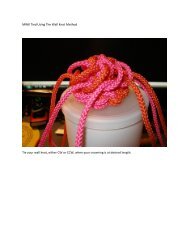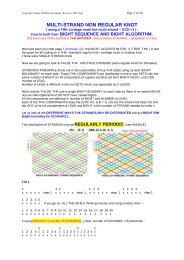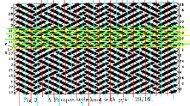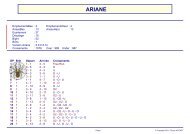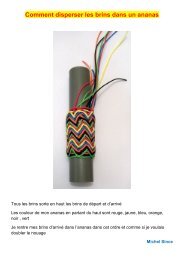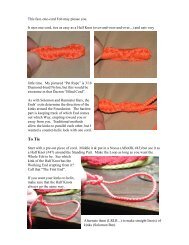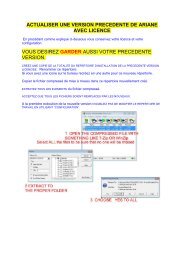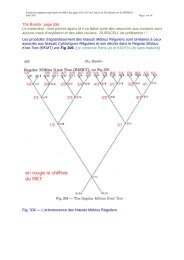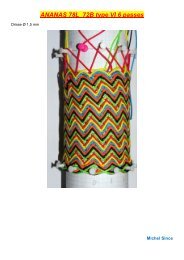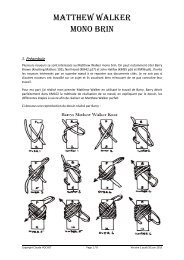STANDARD HERRINGBONE KNOTS (SHK) - Charles HAMEL - Free
STANDARD HERRINGBONE KNOTS (SHK) - Charles HAMEL - Free
STANDARD HERRINGBONE KNOTS (SHK) - Charles HAMEL - Free
You also want an ePaper? Increase the reach of your titles
YUMPU automatically turns print PDFs into web optimized ePapers that Google loves.
Copyright <strong>Charles</strong> <strong>HAMEL</strong> aka Nautile – 2009 Nov PAGE 1 of 33<br />
<strong>STANDARD</strong> <strong>HERRINGBONE</strong> <strong>KNOTS</strong> (<strong>SHK</strong>)<br />
It was difficult to summarize in less than 3 dozens of pages hundreds of pages so,<br />
pray, forgive me if this is a bit of a shamble to read.<br />
Sources ;<br />
- my own observations and reflection<br />
- THE BRAIDER (Schaake & Turner)<br />
- BRAIDING <strong>STANDARD</strong> <strong>HERRINGBONE</strong> <strong>KNOTS</strong> (Schaake & Turner)<br />
- BRAIDING <strong>STANDARD</strong> <strong>HERRINGBONE</strong> PINEAPPLE <strong>KNOTS</strong> (Schaake & Turner)<br />
I made this diagram from the way Schaake dismembered the <strong>SHK</strong><br />
FAMILLY<br />
UNIFORM<br />
PASS<br />
FAMILLY<br />
COMPOUND<br />
PASS<br />
CLASS of REGULAR CYLINDRICAL<br />
‘BRAID LOOKING’ knots with aHerringbone pattern<br />
CLASS of<br />
REGULAR SINGLE STRAND knots<br />
SUB-CLASS<br />
REGULAR or<br />
PERFECT<br />
<strong>HERRINGBONE</strong><br />
knots<br />
Subclass<br />
X<br />
Subclass<br />
Y<br />
SUB-FAMILLY of knots<br />
whose<br />
GDC of L & B is<br />
DIVISIBLE by the<br />
number of PASS A<br />
CLASS of<br />
SEMI-REGULAR (more than 1<br />
STRAND) knots<br />
SUB-CLASS<br />
SEMI-<br />
REGULAR<br />
<strong>HERRINGBONE</strong><br />
knots<br />
FAMILLY<br />
UNIFORM<br />
PASS<br />
Subclass<br />
W<br />
FAMILLY<br />
COMPOUND<br />
PASS<br />
Subclass<br />
Z<br />
SUB-FAMILLY of knots<br />
whose<br />
GDC of L & B is<br />
NOT DIVISIBLE by the<br />
number of PASS A
Copyright <strong>Charles</strong> <strong>HAMEL</strong> aka Nautile – 2009 Nov PAGE 2 of 33<br />
The knots we are speaking about here, the <strong>STANDARD</strong> <strong>HERRINGBONE</strong> <strong>KNOTS</strong> (<strong>SHK</strong>),<br />
are assemblies of Turk’s-Head knots THK) , just as Standard Herringbone Pineapple<br />
knots (SHPAK) are assemblies of Turk’s-Head knots, and just as are many<br />
interweaves of THK that are neither <strong>SHK</strong> or SHPAK.<br />
BUT (a big, a very BIG BUT) in the <strong>SHK</strong> the components THK are ALL IDENTICAL plus<br />
those THK are not using several staged BIGHT RIM as Pineapple do.<br />
<strong>SHK</strong> use only one rim as THK do.<br />
The immediate implication is that there is NO NESTED-BIGHT in a <strong>SHK</strong> while those<br />
nested-bights are a ‘must have’ for a SHPAK.<br />
The first step in the making of an A-PASS <strong>SHK</strong> (A being a positive integer number, 1<br />
to N) is the laying of a foundation knot, in other word the making of a first THK.<br />
When this first laid knot is finished then a second THK of identical dimensions in<br />
Lead and Bight is interwoven with it following a particular coding.<br />
This make 2 THK assembled so it is a 2-PASS <strong>SHK</strong>. That is the biggest PASS<br />
dimension I was able to find published before Schaake & Turner.<br />
If a third THK is put in this will gives a 3-PASS <strong>SHK</strong> and so on.<br />
2-PASS 3-PASS 4-PASS 5-PASS 6-PASS 7-PASS is<br />
even-PASS odd-PASS even-PASS odd-PASS even-PASS odd-PASS<br />
1, 2, 3,7, 8…, n-3, n-2 .n-1, n is called by Schaake the sequence numbers A<br />
in the making of the knot.<br />
As we shall see, when “using a pair of universal algorithm-tables» to make a <strong>SHK</strong><br />
one of the pair of tables is for the even-PASS and the other for the odd –PASS.<br />
THE INTERWOVEN THK HAVE TO BE POSITIONED RELATIVE TO THE<br />
FOUNDATION THK ACCORDING TO A CERTAIN ORDER.<br />
This order is given by the SEQUENCE RULE.<br />
Of course as regular as possible a physical interval positioning of the start points of<br />
the component THK around the rim of the <strong>SHK</strong> is the best to do.<br />
Schaake made a distinction between (horizontal mandrel frame of reference) two<br />
“”””braiding”””” (how I hate that word in this context !) direction:<br />
One laying direction is UPWARD, he other is DOWNWARD.<br />
After this very short introduction let us dig just a bit deeper.
Copyright <strong>Charles</strong> <strong>HAMEL</strong> aka Nautile – 2009 Nov PAGE 3 of 33<br />
‘Lifted’ straight fromSCHAAKE & TURNER in fair quote as this cannot be told better<br />
and illustrated better. A GENERAL <strong>HERRINGBONE</strong> CODING
Copyright <strong>Charles</strong> <strong>HAMEL</strong> aka Nautile – 2009 Nov PAGE 4 of 33<br />
Schaake remarked<br />
that “it is impossible<br />
to discover general<br />
rules if we don’t go<br />
beyond this 2-<br />
PASS barrier to<br />
realize the<br />
existence of what<br />
he call “the<br />
fascinating<br />
sequence rule”.<br />
(GRANT left it at<br />
2-PASS)<br />
This is probably the<br />
reason why there is<br />
no <strong>SHK</strong> over 2-<br />
PASS having been<br />
published<br />
This sequence is<br />
the sequence of the<br />
position of each of<br />
the component<br />
Turk’s-head knots<br />
forming the <strong>SHK</strong><br />
relative to the very<br />
first laid one: the<br />
foundation knot.<br />
Obviously any <strong>SHK</strong><br />
has a<br />
<strong>HERRINGBONE</strong><br />
PATTERN, one<br />
that is INTER-<br />
BIGHT CODED.<br />
(ROW CODED for<br />
SCHAAKE’s frame of<br />
reference = horizontal<br />
mandrel, but is<br />
COLUMN CODED on the vertical cylinder ; that is why I dislike these appellations that are much too<br />
frame-dependent. What I propose is not = INTER-BIGHT and PARALLEL BIGHT but I have<br />
expounded on that point elsewhere in my web pages)<br />
You can see that sequence rule in the pattern when using colours:<br />
The above and under illustration are modifications in a fair quote of SCHAAKE & TURNER:<br />
I colorized them not to make them prettier or different but to make them clearer.<br />
To quote the authors themselves of BRAIDING <strong>STANDARD</strong> <strong>HERRINGBONE</strong> <strong>KNOTS</strong><br />
“We do know that the presentation of the various grid-diagrams would be considerably<br />
improved (my emphasis with italics) by the use of colour printing; however, the very small demand for<br />
these books, and hence the small number of copies printed (a maximum of 50), unfortunately prohibits<br />
this.”
Copyright <strong>Charles</strong> <strong>HAMEL</strong> aka Nautile – 2009 Nov PAGE 5 of 33<br />
<strong>SHK</strong> are an assembly,<br />
an interweave, of 2 to n<br />
( that is what define the<br />
number of PASS : ‘A’)<br />
Turk’s head knots that<br />
are ALL of the same<br />
dimension in LEAD and<br />
BIGHT (contrary to<br />
Herringbone Pineapple who<br />
have TWO SET of THK , even<br />
if one of the SET can be<br />
“empty” ) so there will be<br />
NO nested bight<br />
possible in a <strong>SHK</strong> as<br />
must exist in Herringbone<br />
Pineapple.<br />
The sequence rule<br />
implies a rhythm, a<br />
‘predictability’ that allows<br />
the construction of tables<br />
giving the construction of<br />
<strong>SHK</strong>.<br />
In a <strong>SHK</strong> the total number<br />
of BIGHT will be A (the<br />
number of PASS) time B *<br />
(number of BIGHT of the<br />
component THK.)<br />
A 3 PASS <strong>SHK</strong> with<br />
THK components of 4L* 5B* dimension will have 3 * 5 B* = 15 B (B*is for<br />
component, B is for <strong>SHK</strong> )<br />
As there are 2 ROW ( Schaake’s frame of reference = horizontal mandrel I will use all<br />
along this article ) per BIGHT there will be a total of 2 * 15 = 30 rows<br />
As (contrary to what exist in a Herringbone Pineapple) all the BIGHT of the <strong>SHK</strong> are on a<br />
unique BIGHT-RIM ( or bight-boundary to speak like S & T ) there will L = 2 * L*<br />
Total number of leads in the <strong>SHK</strong><br />
In this case 4 * 3 = 12 LEAD.<br />
So L-1 or ( 12 – 1 = 11 ) columns of crossings alignment in the <strong>SHK</strong>.<br />
UNIFORM-PASS == all Ai are have the same value A ( all the PASS are equal )<br />
COMPOUND == there are several dimensions (at least two different) of SET of PASS<br />
At least two Ai have different numerical value ( see at the very end of this document.
Copyright <strong>Charles</strong> <strong>HAMEL</strong> aka Nautile – 2009 Nov PAGE 6 of 33<br />
Of course the components THK have their L* and B* complying with the GDC=1 rule<br />
to be single-strand knots.<br />
For a single strand THK , which the component THK are in our UNIFORM A-PASS<br />
SEMI-REGULAR <strong>SHK</strong>, the GDC of L* and B* is ‘1’ but the <strong>SHK</strong> will have<br />
L = ( A * L*) and B = ( A * B*) .<br />
Obviously the L & B do not comply with the GDC=1 rule. (I hope it is startlingly<br />
evident for every one; unless you count the foundation THK as a 1-PASS <strong>SHK</strong> which<br />
would be ridiculous in the “real 3D world” if acceptable in “the theory”)<br />
So L and B of the <strong>SHK</strong> have a GDC(<strong>SHK</strong>) > 1 for the <strong>SHK</strong> with A>=2 PASS<br />
This GDC(<strong>SHK</strong>)<br />
Either IS divisible by A (number of PASS)<br />
Or IS NOT divisible by A<br />
That makes for two different sub-families. (see first diagram illustration given )<br />
If GDC(<strong>SHK</strong>) IS divisible by A<br />
Then that means that GDC(<strong>SHK</strong>) = n * A ( n being a positive integer +1 to as great a<br />
number as you want ; that is obvious )<br />
3-PASS 24 L 15B GDC= 3 n=1 |||| 2-PASS 30L 24B GDC=6 n=3<br />
2-PASS 24L 20B GDC= 4 n=2<br />
A <strong>SHK</strong> made with n*A strands ( with n*A >1 of course) will be a<br />
UNIFORM A-PASS SEMI-REGULAR n*A STRANDS <strong>HERRINGBONE</strong> <strong>KNOTS</strong><br />
BUT there is still a dichotomy in those knot to be observed :<br />
Those where n is an ODD number : they will have n*A TURK’S-HEAD KNOT<br />
COMPONENT<br />
and<br />
Those where n is and EVEN number : they will have n*A MATTHEW WALKER KNOT<br />
COMPONENT ) -see illustration on next page-<br />
SCHAAKE insists on this point:<br />
“We emphasize that the interwoven knots of a Semi-Regular Herringbone Knot play<br />
an important role in its classification”<br />
Let us stay with SCHAAKE<br />
“In this book we shall limit our discussion to the ‘A-pass nA_string Herringbone<br />
Knots’ for which the value of n is equal to 1 (hence the value of A is greater than 1) ;<br />
these knots are called the Standard Herringbone Knots. Since 1 is an odd positive<br />
integer, an A-pass Standard Herringbone Knot with p-parts and b-bights consists of A<br />
interwoven Turk’s-head knots, each of which has p*=p/A parts and b*=b/A bights “
Copyright <strong>Charles</strong> <strong>HAMEL</strong> aka Nautile – 2009 Nov PAGE 7 of 33<br />
(BRAIDING <strong>STANDARD</strong> <strong>HERRINGBONE</strong> <strong>KNOTS</strong> does not treat of the<br />
COMPOUND-PASS semi-regular herringbone knots or the UNIFORM-PASS semiregular<br />
herringbone knots). The Authors treat differently the UPWARD and the<br />
DOWNWARD ways to make these knots. I will keep only the UPWARD ( mandrel frame)
Copyright <strong>Charles</strong> <strong>HAMEL</strong> aka Nautile – 2009 Nov PAGE 8 of 33<br />
Tables will be for L* and B* values of the component THK.<br />
We will have to distinguish L* (odd) and L* (even)<br />
For each pair of L*ODD & B* values there will be a pair of SO tables :<br />
One for the ODD numbered PASS<br />
One for the EVEN numbered PASS<br />
For each pair of L*EVEN & B* values there will be a pair of SE tables :<br />
One for the ODD numbered PASS<br />
One for the EVEN numbered PASS<br />
In the book there are 32 PAIRS of READY-MADE tables looking like the one down<br />
here in page 14.
Copyright <strong>Charles</strong> <strong>HAMEL</strong> aka Nautile – 2009 Nov PAGE 9 of 33<br />
How does one draw the LAYOUT of the cells of the ALGORITHM TABLES ?<br />
Here is some tips.<br />
SET NUMBER ……..<br />
L to R reference ……..<br />
R to L reference ……..<br />
Half- L to R ……..<br />
period 1<br />
Halfperiod<br />
2<br />
Halfperiod<br />
3<br />
Halfperiod<br />
2B* - 1<br />
Halfperiod<br />
2B*<br />
R to L ……..<br />
L to R ……..<br />
……..<br />
L to R ……..<br />
R to L ……..<br />
ALL the tables will be drawn like this one just above.<br />
Now for the particular TYPES : TYPE SO and TYPE SE<br />
SO THK component (that is NOT the whole <strong>SHK</strong>) with ODD number of LEAD<br />
SE THK component with EVEN number of LEAD<br />
The following template applies to both TYPE SO and TYPE SE as far as drawing<br />
their “frame” is concerned but the value to be entered in each of the yellow<br />
cells depends on the SO or SE nature.
Copyright <strong>Charles</strong> <strong>HAMEL</strong> aka Nautile – 2009 Nov PAGE 10 of 33<br />
So (or SE) L*ODD (or L*EVEN) with B* such that GDC = 1<br />
ODD numbered A<br />
SET NUMBER 1 2 3 4 …….. L*- 2 L*- 1<br />
L to R reference ……..<br />
R to L reference ……..<br />
Half- L to R ……..<br />
period 1<br />
Halfperiod<br />
2<br />
Halfperiod<br />
3<br />
Halfperiod<br />
2B* - 1<br />
Halfperiod<br />
2B*<br />
EVEN numbered A<br />
SET NUMBER 1 2 3 …….. L*- 3 L*- 2 L*- 1<br />
L to R reference ……..<br />
R to L reference ……..<br />
Half- L to R ……..<br />
period 1<br />
Halfperiod<br />
2<br />
Halfperiod<br />
3<br />
Halfperiod<br />
2B* - 1<br />
Halfperiod<br />
2B*<br />
R to L ……..<br />
L to R ……..<br />
……..<br />
L to R ……..<br />
R to L ……..<br />
R to L ……..<br />
L to R ……..<br />
……..<br />
L to R ……..<br />
R to L ……..
Copyright <strong>Charles</strong> <strong>HAMEL</strong> aka Nautile – 2009 Nov PAGE 11 of 33<br />
Let us be slow in our progress: READ VERY ATTENTIVELY, DECIPHER<br />
COMPLETELY BEFORE PROCEEDING ALONG.<br />
DON’T RUSH THE VERY SOFT LEARNING CURVE I AM TRYING TO BUILD FOR<br />
YOU.<br />
So L*ODD with B* such that GDC = 1<br />
ODD numbered A<br />
SET NUMBER 1 2 3 4 …….. L*- 2 L*- 1<br />
L to R reference A -1 A –1 A -1 A –1 …….. A -1 A –1<br />
U O U O<br />
U O<br />
R to L reference A -1 A –1 A -1 A –1 …….. A -1 A –1<br />
U O U O<br />
U O<br />
EVEN numbered A<br />
SET NUMBER 1 2 3 …….. L*- 3 L*- 2 L*- 1<br />
L to R reference A -1 A –1 A -1 A –1 …….. A -1 A –1 A -1<br />
U O U O<br />
U O U<br />
R to L reference A -1 A –1 A -1 A –1 …….. A -1 A –1 A -1<br />
U O U O<br />
U O U<br />
SE L*EVEN with B* such that GDC = 1<br />
ODD numbered A<br />
SET NUMBER 1 2 3 4 …….. L*- 2 L*- 1<br />
L to R reference A -1 A –1 A -1 A –1 … … . . A –1 A -1<br />
U O U O<br />
O U<br />
R to L reference A –1 A -1 A –1 A -1 … … . . A -1 A –1<br />
O U O U<br />
U O<br />
EVEN numbered A<br />
A -1<br />
U<br />
A -1<br />
U<br />
A –1<br />
O<br />
A -1<br />
U<br />
SET NUMBER 1 2 3 …….. L*- 3 L*- 2 L*- 1<br />
L to R reference A -1 A –1 A -1<br />
…….. A –1 A -1 A –1<br />
U O U<br />
O U O<br />
R to L reference A –1 A -1 A –1 A -1 …….. A -1 A –1 A -1<br />
O U O U<br />
U O U
Copyright <strong>Charles</strong> <strong>HAMEL</strong> aka Nautile – 2009 Nov PAGE 12 of 33<br />
Now a pair of whole tables<br />
So L*ODD with B* such that GDC = 1<br />
ODD numbered A<br />
SET NUMBER 1 2 3 4 …….. L*- 2 L*- 1<br />
L to R reference A -1 A –1 A -1 A –1 …….. A -1 A –1 A -1<br />
U O U O<br />
U O U<br />
R to L reference A -1 A –1 A -1 A –1 …….. A -1 A –1 A -1<br />
U O U O<br />
U O U<br />
Half- L to R A - 1 A - 1 A - 1 A - 1 …….. A - 1 A - 1 A - 1<br />
period 1<br />
Halfperiod<br />
2<br />
Halfperiod<br />
3<br />
…..<br />
…..<br />
…..<br />
…..<br />
Halfperiod<br />
2B* - 1<br />
Halfperiod<br />
2B*<br />
EVEN numbered A<br />
SET NUMBER 1 2 3 …….. L*- 3 L*- 2 L*- 1<br />
L to R reference A -1 A –1 A -1 A –1 …….. A -1 A –1 A -1<br />
U O U O<br />
U O U<br />
R to L reference A -1 A –1 A -1 A –1 …….. A -1 A –1 A -1<br />
U O U O<br />
U O U<br />
Half- L to R A - 1 A - 1 A - 1 A - 1 …….. A - 1 A - 1 A - 1<br />
period 1<br />
Halfperiod<br />
2<br />
Halfperiod<br />
3<br />
…..<br />
…..<br />
…..<br />
…..<br />
Halfperiod<br />
2B* - 1<br />
Halfperiod<br />
2B*<br />
R to L …….. A - 1<br />
L to R …….. A - 1<br />
…..<br />
…..<br />
…..<br />
…..<br />
R to L A - 1 ……..<br />
L to R A - 1 ……..<br />
…..<br />
…..<br />
…..<br />
…..<br />
…..<br />
…..<br />
…..<br />
…..<br />
…..<br />
…..<br />
…..<br />
…..<br />
…..<br />
…..<br />
…..<br />
…..<br />
…..<br />
…..<br />
…..<br />
…..<br />
…..<br />
…..<br />
…..<br />
…..<br />
…..<br />
…..<br />
…..<br />
…..<br />
…..<br />
…..<br />
…..<br />
…..<br />
…..<br />
…..<br />
…..<br />
…..<br />
…..<br />
…..<br />
…..<br />
…..<br />
…..<br />
…..<br />
…..<br />
…..<br />
…..<br />
…..<br />
L to R A - 1 ……..<br />
R to L A - 1 ……..<br />
…..<br />
…..<br />
…..<br />
…..<br />
…..<br />
…..<br />
…..<br />
…..<br />
…..<br />
…..<br />
…..<br />
…..<br />
…..<br />
…..<br />
…..<br />
…..<br />
…..<br />
…..<br />
…..<br />
…..<br />
L to R …….. A - 1<br />
R to L …….. A - 1<br />
…..<br />
…..<br />
…..<br />
…..
Copyright <strong>Charles</strong> <strong>HAMEL</strong> aka Nautile – 2009 Nov PAGE 13 of 33<br />
SE L*EVEN with B* such that GDC = 1<br />
ODD numbered A<br />
SET NUMBER 1 2 3 4 …….. L*- 2 L*- 1<br />
L to R reference A -1 A –1 A -1 A –1 … … . . A –1 A - 1 A –1<br />
U O U O<br />
O U O<br />
R to L reference A –1 A -1 A –1 A -1 … … . . A - 1 A – 1 A -1<br />
O U O U<br />
U O U<br />
Half-period 1 L to R A - 1 A - 1 A - 1 A - 1 …….. A - 1 A - 1 A -1<br />
Half-period 2 R to L …….. A -1<br />
Half-period 3 L to R …….. A - 1<br />
…..<br />
…..<br />
…..<br />
…..<br />
Half-period<br />
2B* - 1<br />
Half-period 2B*<br />
EVEN numbered A<br />
SET NUMBER 1 2 3 …….. L*- 3 L*- 2 L*- 1<br />
L to R reference A -1 A –1 A -1<br />
…….. A –1 A - 1 A –1<br />
U O U<br />
O U O<br />
R to L reference A –1 A -1 A –1 A -1 …….. A - 1 A –1 A - 1<br />
O U O U<br />
U O U<br />
Half- L to R A - 1 A - 1 A - 1 A - 1 …….. A - 1 A - 1 A - 1<br />
period 1<br />
Halfperiod<br />
2<br />
Halfperiod<br />
3<br />
…..<br />
…..<br />
…..<br />
…..<br />
Halfperiod<br />
2B* - 1<br />
Halfperiod<br />
2B*<br />
R to L A - 1 ……..<br />
L to R A - 1 ……..<br />
…..<br />
…..<br />
…..<br />
…..<br />
….. ….. ….. ….. ….. ….. ….. ….. …..<br />
….. ….. ….. ….. ….. ….. ….. ….. …..<br />
….. ….. ….. ….. ….. ….. ….. ….. …..<br />
….. ….. ….. ….. ….. …..<br />
…..<br />
….. ….. …..<br />
L to R …….. A -1<br />
R to L …….. A - 1<br />
…..<br />
…..<br />
…..<br />
…..<br />
…..<br />
…..<br />
…..<br />
…..<br />
…..<br />
…..<br />
…..<br />
…..<br />
…..<br />
…..<br />
…..<br />
…..<br />
…..<br />
…..<br />
…..<br />
…..<br />
…..<br />
L to R A - 1 ……..<br />
R to L A - 1 ……..<br />
…..<br />
…..<br />
…..<br />
…..<br />
…..<br />
…..<br />
…..<br />
…..<br />
…..<br />
…..<br />
…..<br />
…..
Copyright <strong>Charles</strong> <strong>HAMEL</strong> aka Nautile – 2009 Nov PAGE 14 of 33<br />
Now for an example of how to put a table to use:<br />
Table above and under are quoted directly, unmodified, from Schaake<br />
Let us say A =1 then that read:<br />
Set number 1 1 2 3 4<br />
HP 1 L to R 0 0 0 0 0<br />
HP 2 R to L 0 0 0 0 0<br />
HP 3 L to R 0 0 0 1 0<br />
HP 4 R to L 0 0 1 1 0<br />
HP 5 L to R 0 0 1 1 0<br />
HP 6 R to L 0 1 1 1 0<br />
HP 7 L to R 0 1 1 1 0<br />
HP 8 R to L 1 1 1 1 0<br />
Set number 1 1 2 3 4<br />
HP 1 L to R U0 O0 U0 O0 U0<br />
HP 2 R to L U0 O0 U0 O0 U0<br />
HP 3 L to R U0 O0 U0 O1 U0<br />
HP 4 R to L U0 O0 U1 O1 U0<br />
HP 5 L to R U0 O0 U1 O1 U0<br />
HP 6 R to L U0 O1 U1 O1 U0<br />
HP 7 L to R U0 O1 U1 O1 U0<br />
HP 8 R to L U1 O1 U1 O1 U0
Copyright <strong>Charles</strong> <strong>HAMEL</strong> aka Nautile – 2009 Nov PAGE 15 of 33<br />
Let us say that A = 4 then that read:<br />
Set number<br />
1<br />
2 3 4 5<br />
HP 1 L to R 3 3 3 3 3<br />
HP 2 R to L 3 3 3 3 4<br />
HP 3 L to R 3 3 3 3 4<br />
HP 4 R to L 3 3 3 4 4<br />
HP 5 L to R 3 3 3 4 4<br />
HP 6 R to L 3 3 4 4 4<br />
HP 7 L to R 3 3 4 4 4<br />
HP 8 R to L 3 4 4 4 4<br />
Set number 1 2 3 4 5<br />
H P 1 L to R U3 O3 U3 O3 U3<br />
H P 2 R to L U3 O3 U3 O3 U4<br />
H P 3 L to R U3 O3 U3 O3 U4<br />
H P 4 R to L U3 O3 U3 O4 U4<br />
H P 5 L to R U3 O3 U3 O4 U4<br />
H P 6 R to L U3 O3 U4 O4 U4<br />
H P 7 L to R U3 O3 U4 O4 U4<br />
H P 8 R to L U3 O4 U4 O4 U4<br />
Calculate the value of A and (A-1) and search the U / O coding in the second or third<br />
row as is the case (L to R for odd numbered Half-Period and R to L for even<br />
numbered H-P)
Copyright <strong>Charles</strong> <strong>HAMEL</strong> aka Nautile – 2009 Nov PAGE 16 of 33<br />
Using algorithm tables you can make any A-PASS <strong>STANDARD</strong><br />
<strong>HERRINGBONE</strong> KNOT<br />
About the SET NUMBER :<br />
In a completely finished <strong>SHK</strong>, for each half-period, it is possible to separate the<br />
crossing existing along this half-period in SET OF CROSSINGS in such a way that<br />
IN A GIVEN SET ALL THE ADJACENT CROSSINGS IN IT ARE OF THE SAME<br />
TYPE : OVER / UNDER.<br />
IN ALL CASES THE NUMBER OF SETS IS EQUAL TO L*, the number of LEAD<br />
in any one of the component THK (components are all of identical dimension.)<br />
BUT we do not give a number to ALL of these SET (think about the BLACK CELL<br />
either at the beginning or the end of the row of set number)<br />
The set without number, the one with the caviar-ed (a term from French printedmatter<br />
censure meaning “covered with black ink” as if a toast with caviar) cell is THE<br />
ONE WHERE THE NUMBER OF CROSSING WILL NOT CHANGE WHEN MAKING<br />
THE KNOT.<br />
THE CELL / SET WHICH WILL NOT BE NUMBERED AND WILL GET THE BLACK CELL IS IN<br />
THE TABLES:<br />
THE VERY LAST ONE in the case of the NUMBER SEQUENCE of A being ODD.<br />
THE VERY FIRST ONE in the case of the NUMBER SEQUENCE of A being EVEN.<br />
So only (L* – 1) sets will get a number but there will be L* cells in the SET<br />
NUMBER row, the discrepancy being the “black cell”.<br />
The same SET NUMBER ( say 3 ) figures in both and ODD-numbered HP L to R and<br />
in an EVEN-numbered HP R to L BUT that set number DOES NOT GO with the<br />
same crossings so NOT to the same SET of crossing.
Copyright <strong>Charles</strong> <strong>HAMEL</strong> aka Nautile – 2009 Nov PAGE 17 of 33<br />
The second and third rows give the REFERENCE QUANTITY (A-1 ) and the TYPE<br />
OVER / UNDER of the CROSSING<br />
SET NUMBER 1 2 3 4 …….. L*- 2 L*- 1<br />
L to R reference A -1 A –1 A -1 A –1 …….. A -1 A –1<br />
U O U O<br />
U O<br />
R to L reference A -1 A –1 A -1 A –1 …….. A -1 A –1<br />
U O U O<br />
U O<br />
SET NUMBER 1 2 3 …….. L*- 3 L*- 2 L*- 1<br />
L to R reference A -1 A –1 A -1<br />
…….. A –1 A -1 A –1<br />
U O U<br />
O U O<br />
R to L reference A –1 A -1 A –1 A -1 …….. A -1 A –1 A -1<br />
O U O U<br />
U O U<br />
The algorithm tables previously given were entered with the NON-CHANGING<br />
values<br />
As for the remainder of the cells they may stay at (A-1) value or may have to be<br />
push up to (A) value.<br />
Which cells are affected by the change depend on L* and B*<br />
We have to address the calculation of the SET NUMBERS which are to be increased.<br />
HOW TO CALCULATE THE ALGORITHM TABLES<br />
SCHAAKE offers THREE METHODS : (A) (do not mix that with A for PASS !) (B) and (C)<br />
METHOD (A) and METHOD (B) : “ [quote] “ are essentially the same ; (A)<br />
does not use mathematics, whereas (B) does. Method (C) also uses<br />
some mathematics “ [/quote]<br />
METHOD (A) and METHOD (B) use “ the complementary cyclic bight-number<br />
scheme “ of the interwoven THK component. That scheme we have seen else<br />
where.<br />
Combining this complementary-cyclic with the set-numbers we can determine for a<br />
given half-period which of its set number are increased from (A-1) to (A).<br />
MODULAR ARITHMETICS are in use of course ! ;-)<br />
A -1<br />
U<br />
A -1<br />
U
Copyright <strong>Charles</strong> <strong>HAMEL</strong> aka Nautile – 2009 Nov PAGE 18 of 33<br />
BE REMINDED that in publications_3 are my HP48 programs.<br />
They calculate all that will be used here so I will not go again on that well trodden<br />
ground, Just go back to the necessary pages and PDF in Publication and in<br />
Turkshead pages. Study the books and THE BRAIDER to be fully enlightened.<br />
METHOD ( A ) & METHOD ( B )<br />
They differ from one another by the method used to write the complementary cyclic:<br />
--- METHOD (A) use the slow slogging method of ( -L*)modulo B*<br />
--- METHOD (B) use the DELTA and DELTA* where<br />
This formula gives DELTA*<br />
with m* being of such value integer value ( negative, zero or<br />
positive) that the quantity _____________________________<br />
is the smallest possible.<br />
Let us say that we were able to write the complementary cyclic for L* = 9 B* = 4<br />
using either the programs I gave or the equations that SCHAAKE gave in THE<br />
BRAIDER and other books.<br />
______________________________________________________<br />
0 3 2 1<br />
* * * *<br />
Then we write___________________________________________<br />
# * * * * * * * *<br />
0 1 2 3 4 5 6 7 8<br />
Then__________________________________________________<br />
0 3 2 1<br />
# * * * * * * * *<br />
0 1 2 3 4 5 6 7 8<br />
Then__________________________________________________<br />
0 3 2 1 0 3 2 1 0<br />
# * * * * * * * *<br />
0 1 2 3 4 5 6 7 8<br />
______________________________________________________<br />
This last is called the SET DIAGRAM<br />
It is all that is necessary to be able to get the algorithm-tables entries HAVE TO BE<br />
INCREASED FROM ( A-1) to (A). We address that a bit later.<br />
( this set-diagram can be extended to algorithm-diagrams which make the<br />
algorithm-tables ‘discard-able’ as it is possible to make the <strong>SHK</strong> directly from them)<br />
In SCHAAKE’s own words “ However this method is generally not recommended<br />
for the novice ; he should first master all the procedures outlined in all the<br />
other Chapters “
Copyright <strong>Charles</strong> <strong>HAMEL</strong> aka Nautile – 2009 Nov PAGE 19 of 33<br />
Given that most persons I encountered in the flesh, by mail or on Net forum don’t<br />
seem to be easily able to grasp how to use the simpler methods then this is a very<br />
dire warning indeed ! ;-)<br />
Brains will over-fry for sure! ROTFLOL<br />
First (this is also given as an HP48GX program of mine and explained in some Turks head pages ) it is<br />
necessary to call back to mind the relationship between half-periods and bightnumbers<br />
We need to calculate the bight-number associated with the half-period<br />
( I have pity on you : recall i = ( heven - 2 ) / 2 and i = ( hodd - 3 ) / 2 where h is the<br />
number attributed to the half-period )<br />
METHOD ( C ) use<br />
This table looks a lot like the table in use for <strong>STANDARD</strong> REGULAR KNOT<br />
(knot on a THK cordage route). For the Standard Herringbone PINEAPPLE<br />
knots a table built along those lines is used.
Copyright <strong>Charles</strong> <strong>HAMEL</strong> aka Nautile – 2009 Nov PAGE 20 of 33<br />
The 3 TABLES GIVEN HERE ARE QUOTED FROM SCHAAKE & TURNER ( you<br />
will have them and their full User-Manual by buying the CD with the 5 PDF of the<br />
books.)<br />
Calculation-table for additional set-number intersections for Herringbone<br />
PINEAPPLE knots
Copyright <strong>Charles</strong> <strong>HAMEL</strong> aka Nautile – 2009 Nov PAGE 21 of 33<br />
Calculation-table for REGULAR <strong>KNOTS</strong> (those made on a THK cordage route)<br />
_________________________________<br />
With any of those methods (A), (B) and (C) you should be able to draw the<br />
algorithm tables for any <strong>STANDARD</strong> <strong>HERRINGBONE</strong> KNOT you care to make.<br />
SCHAAKE & TURNER provided a LOT of tables pairs in their book on those knots<br />
and Tom HALL provided the hand drawings helping the untrained brains and eyes<br />
with interpreting the isometric grid diagrams.
Copyright <strong>Charles</strong> <strong>HAMEL</strong> aka Nautile – 2009 Nov PAGE 22 of 33<br />
Now let us see how to get the algorithm-tables entries THAT HAVE TO BE INCREASED<br />
FROM (A-1) to (A).<br />
Reminder :<br />
The reference algorithm for any ODD numbered half-periods is :<br />
( L – 1 ) U (A – 1 ) O (A – 1 ) U (A – 1 ) O (A – 1 ) U …….<br />
(A – 1 ) O (A – 1 ) U (A – 1 ) O (R – 1 ) U<br />
The reference algorithm for any EVEN numbered half-periods is :<br />
(R – 1 ) U (A – 1 ) O (A – 1 ) U (A – 1 ) O (A – 1 ) U …….<br />
(A – 1 ) O (A – 1 ) U (A – 1 ) O (L – 1 ) U<br />
The algorithm for Half-Period ONE is always identical to the reference algorithm<br />
for an ODD half-period. NO CHANGE OCCURS.<br />
So half-period 1 has each of its cells with the value of ( A – 1 )<br />
As for the rest of the half-periods the reference values ( L – 1 ) and (R – 1 ) may<br />
have increased by ONE for some cells in set-number 1, and the (A – 1 ) may<br />
have increased by ONE for some cells in some set-number.<br />
So ( L – 1 ) becomes ( L ) and (R – 1 ) becomes (R ) , while (A – 1) becomes (A)<br />
In the last column (in the reading direction L to R and R to L respectively) no<br />
change occurs.<br />
Look at the table in page 19, the first table given for METHOD (C), which allows to<br />
calculate in which cells ( set-number) those changes have to be done.<br />
This is what my HP48 HER3 program does.<br />
Let us let go of the algorithm-tables and attempt to look at the algorithm-diagrams<br />
(using a set-diagram) that were overflown quite swiftly in METHOD (A) and METHOD (B)
Copyright <strong>Charles</strong> <strong>HAMEL</strong> aka Nautile – 2009 Nov PAGE 23 of 33<br />
ALGORITHM-DIAGRAMS FOR THE <strong>SHK</strong><br />
Remember ? :<br />
We need a PAIR of tables (one for ODD numbered PASS , one for EVEN numbered<br />
PASS) for EACH type S0 (Sodd) and SE (Seven) of <strong>SHK</strong> depending on the parity of<br />
L*, the component THK number of LEAD.<br />
I do hope that Schaake was not mistaken (given my experience with persons saying they are<br />
knot-tyer I fear he was! ) when he wrote what looks like wishful thinking :<br />
“Most braiders will eventually use the algorithm-diagram method<br />
exclusively, due to its overall compactness and simplicity. Especially with<br />
regard to the Standard Herringbone Knot of Type So, a very compact<br />
and simple algorithm-diagram can be constructed. This type of Standard<br />
Herringbone Knot is the most universally applicable one since it always<br />
create a symmetrical colour-pattern when colour strings are used in its<br />
construction. ……. ….. We must stress that there are a number of<br />
applications where the aesthetic quality of the braided artifact would be<br />
considerably enhanced by using a Type SE instead of a type SO Standard<br />
Herringbone Knot. For this reason we shall not discuss the most<br />
simple and compact form of the algorithm-diagram that can be<br />
constructed for the Type SO Standard Herringbone Knot, but rather<br />
discuss the form which is similar to the one used for the Type SE<br />
Standard Herringbone Knot “<br />
As we have seen previously in this document we need the complementary-cyclic<br />
bight numbers of the THK components that are interwoven to build a <strong>SHK</strong>.<br />
I treated that complementary-cyclic at length in other web pages on Turk’s head<br />
knots and gave personal HP48 programs that deal with all that is necessary.<br />
The algorithm-diagram being a PRACTICAL TOOL it will be made in such a<br />
manner that the ( L to R ) ODD numbered half-periods that are read ( L to R ) will be<br />
indeed read ( L to R ) and that the ( R to L ) EVEN numbered half-periods that must<br />
be read ( R to L ) will indeed be read ( R to L ).<br />
This is a very important point to keep in mind. Many persons find that difficult even<br />
with the simple Regular Knots (THK for example)<br />
Mind to not forget to comply with the sequence rule.
Copyright <strong>Charles</strong> <strong>HAMEL</strong> aka Nautile – 2009 Nov PAGE 24 of 33<br />
ALGORITHM-DIAGRAM FOR SO<br />
A real example from which you will infer the general procedure.<br />
L* = 7 B*=6<br />
First we get the complementary-cyclic bight number sequence<br />
(-7)mod 6 = 5 ( also usable are m*and DELTA* )<br />
_________________________________________________________________<br />
So . . . . . . ( as many ‘.’ as B* )<br />
_________________________________________________________________<br />
0 0 1<br />
. . . . . . . . . . . .<br />
_________________________________________________________________<br />
0 2 1 0 5 3 4 2 1<br />
. . . . . . . . . . . .<br />
_________________________________________________________________<br />
We have now to put that complementary cyclic in<br />
(as many * than L*-1 and one # at each extremity)<br />
_________________________________________________________________<br />
L to R : U O U O U O (A-1) U<br />
0 5 4 3 2 1 0<br />
A ODD<br />
# * * * * * * #<br />
0 1 2 3 4 5 0<br />
R to L (A-1) U O U O U O U<br />
_____________________________________________________<br />
L to R : (A-1) U O U O U O U<br />
0 5 4 3 2 1 0<br />
A EVEN<br />
# * * * * * * #<br />
0 1 2 3 4 5 0<br />
R to L U O U O U O (A-1) U<br />
_________________________________________________________________<br />
You are set to go !<br />
PASS = 5 ( 5 th THK component, 4 th after the foundation knot) so ODD PASS so<br />
UPPER part, above the line.<br />
We want the half-period 7. ODD numbered half-period so L to R<br />
Compute the bight-number i= ( 7 – 3 ) / 2 = 2
Copyright <strong>Charles</strong> <strong>HAMEL</strong> aka Nautile – 2009 Nov PAGE 25 of 33<br />
SCHAAKE’s reading rules<br />
“all the unspecified number of crossing belonging to a coding type and<br />
corresponding with a bight-number is equal to ( A – 1 ) unless this bightnumber<br />
is smaller than or equal to the bight-number associated with the halfcycle<br />
under consideration, in which case the number of crossings is equal to<br />
A”<br />
For this 7 th half-period ( I have explained elsewhere why I prefer “period” to “cycle” )<br />
We get U4 - O4 - U4 - O5 - U5 - O5 - U4<br />
Now the 10 th half-period in this 5 th PASS<br />
EVEN numbered H-P so R to L with bight-index ( 10 – 2 ) / 2 = 4<br />
We get<br />
_________________________________________________________________<br />
# * * * * * * #<br />
0 1 2 3 4 5 0<br />
R to L (A-1) U O U O U O U<br />
4 5 5 5 5 5 4<br />
Or (A-1) (A ) (A ) (A ) (A ) (A ) (A-1)<br />
U4 - O5 - U5 - O5 - U5 - O5 - U4<br />
_________________________________________________________________<br />
It is the same thing for an EVEN numbered PASS and its ODD or EVEN H-P only<br />
you then use the part UNDER the horizontal line.<br />
It is pretty much the way to use the THK algorithm we have seen in my other web<br />
pages Turkshead and in my HP48GX programs for knot made along a THK cordage<br />
route.<br />
ALGORITHM-DIAGRAM FOR SE<br />
A real example from which you will infer the general procedure<br />
L* = 8 B*=5<br />
(-8)mod 5 = 2 ( or use m*=-1 and DELTA*=3 after calculating them with the<br />
formulas)<br />
Complementary-cyclic bight-number sequence is<br />
0 3 1 4 2<br />
MIND THAT the reference values for L to R and R to L are different from the Type<br />
SO
Copyright <strong>Charles</strong> <strong>HAMEL</strong> aka Nautile – 2009 Nov PAGE 26 of 33<br />
_________________________________________________________________<br />
L to R : U O U O U O U (A-1) O<br />
0 3 1 4 2 0 3 1<br />
A ODD<br />
# * * * * * * * #<br />
1 3 0 2 4 1 3 0<br />
R to L (A-1) U O U O U O U O<br />
_____________________________________________________<br />
L to R : (A-1) U O U O U O U O<br />
0 5 4 3 2 1 0<br />
A EVEN<br />
# * * * * * * * #<br />
1 3 0 2 4 1 3 0<br />
R to L U O U O U O U (A-1) O<br />
_________________________________________________________________<br />
Just one example<br />
3 rd PASS ( 3 rd THK in the <strong>SHK</strong> ) 5 th Half-Period<br />
So ODD numbered PASS and L to R ODD numbered H-P so upper part above the<br />
horizontal line<br />
i=(5-3)/2 = 1 A = 3 (A-1) = 2<br />
so<br />
_________________________________________________________________<br />
U2 – O3 - U2 - O2 - U3 - O2 - U3 - O2<br />
2 3 2 2 3 2 3 2<br />
(A-1) A (A-1) ( A-1) A (A-1) A-1) (A-1)<br />
L to R : U O U O U O U (A-1) O<br />
0 3 1 4 2 0 3 1<br />
A ODD<br />
# * * * * * * * #<br />
_________________________________________________________________<br />
and so on.
Copyright <strong>Charles</strong> <strong>HAMEL</strong> aka Nautile – 2009 Nov PAGE 27 of 33<br />
Last word is left to my source of inspiration : SCHAAKE & TURNER.<br />
“ The algorithm-diagrams provide a much more compact form of the<br />
instructions for the execution of the required steps in the construction of the<br />
Standard Herringbone Knots. Furthermore, the relative position of the<br />
component algorithm-diagrams, associated with the odd and even sequence<br />
numbers, within the overall algorithm-diagram, provides a simple mnemonic<br />
for the relative bight positions of the interbraided Turk’s Head knots in<br />
accordance with the sequence rule, when the upwards braiding direction is<br />
used.”<br />
------------------------------------<br />
As I am not sure that some persons will not miss some points here are some<br />
diagrams of mine in the hope of helping those who can only understand visually.<br />
As can be seen “as a nose in the<br />
middle of the face” 2-PASS have no<br />
“discrimination”<br />
1 2 or 2 1 are similar.<br />
BUT<br />
IF<br />
5 3 1 2 4 is similar to 4 2 1 3 5<br />
BOTH ARE WILDLY AND WIDELY<br />
DIFFERENT FROM<br />
1 2 3 4 5 or 5 4 3 2 1 that do<br />
not comply with the SEQUENCE<br />
RULE<br />
…/…
Copyright <strong>Charles</strong> <strong>HAMEL</strong> aka Nautile – 2009 Nov PAGE 28 of 33<br />
With these two diagrams it is easy to compare two 4-PASS <strong>SHK</strong>, one complying<br />
with the SEQUENCE RULE and the other NOT.
Copyright <strong>Charles</strong> <strong>HAMEL</strong> aka Nautile – 2009 Nov PAGE 29 of 33
Copyright <strong>Charles</strong> <strong>HAMEL</strong> aka Nautile – 2009 Nov PAGE 30 of 33<br />
This diagram allows to see at one glance a Type SO AND a Type SE<br />
Here are two tables with the coding of those two knots so that you<br />
may verify “in the cordage”<br />
TYPE SO 4-PASS 3L* 2B* for a 12L 8B <strong>SHK</strong><br />
PASS 1 PASS 2<br />
H-P 1 <strong>Free</strong> run H-P 1 U1 – O1 – U1<br />
H-P 2 O1 H-P 2 U1 – O1 – U2<br />
H-P 3 O1 H-P 3 U1 – O1 – U2<br />
H-P 4 U1 – O1 H-P 4 U1 – O2 – U1<br />
PASS 3 PASS 4<br />
H-P 1 U2 – O2 – U2 H-P 1 U3 – O3 – U3<br />
H-P 2 U2 – O3 – U2 H-P 2 U3 – O3 – U4<br />
H-P 3 U2 – O3 – U2 H-P 3 U3 – O3 – U4<br />
H-P 4 U3 – O3 – U2 H-P 4 U3 – O4 – U4
Copyright <strong>Charles</strong> <strong>HAMEL</strong> aka Nautile – 2009 Nov PAGE 31 of 33<br />
TYPE SE 4-PASS 4L* 3B* for a 16L 12B <strong>SHK</strong><br />
PASS 1 PASS 2<br />
H-P 1 <strong>Free</strong> run H-P 1 U1 – O1 – U1 – O1<br />
H-P 2 O1 H-P 2 O1 – U1 – O1 – U2<br />
H-P 3 U1 H-P 3 U1 – O1 – U1 – O2<br />
H-P 4 U1 – O1 H-P 4 O1 – U1 – O2 – U2<br />
H-P 5 O1 – U1 H-P 5 U1 – O1 – U2 – O2<br />
H-P 6 O1 - U1 – O1 H-P 6 O1 – U2 – O2 – U2<br />
PASS 3 PASS 4<br />
H-P 1 U2 – O2 – U2 – O2 H-P 1 U3 – O3 – U3 – O3<br />
H-P 2 O2 – U2 – O3 – U2 H-P 2 O3 – U3 – O3 – U4<br />
H-P 3 U2 – O2 – U3 – O2 H-P 3 U3 – O3 – U3 – O4<br />
H-P 4 O2 – U3 – O3 – U2 H-P 4 O3 – U3 – O4 – U4<br />
H-P 5 U2 – O3 - U3 – O2 H-P 5 U3 – O3 – U4 – O4<br />
H-P 6 O3 – U3 – O3 – U2 H-P 6 O3 – U4 – O4 – U4<br />
----------------------------------------------------------------------------------------------------------<br />
A curiosity ‘stolen’ from SCHAAKE & TURNER with the high respect I have for<br />
those men.<br />
You will get dozens of grids and a lot of drawings by Tom HALL illustrating those<br />
grids.<br />
The grids on the influence of colours on pattern are mesmerizing I will give just<br />
‘sample” to entice you to buy the CD ( mind you the pdf book on <strong>SHK</strong> has a few printing<br />
mistakes and a handful of pages (illustration not text ) are missing.)<br />
Note the MIXED PASS : COMPOUND-PASS
Copyright <strong>Charles</strong> <strong>HAMEL</strong> aka Nautile – 2009 Nov PAGE 32 of 33
Copyright <strong>Charles</strong> <strong>HAMEL</strong> aka Nautile – 2009 Nov PAGE 33 of 33<br />
STUDY THE SE and SE BIGHT RIM AND THEIR CHARACTERISTICS


